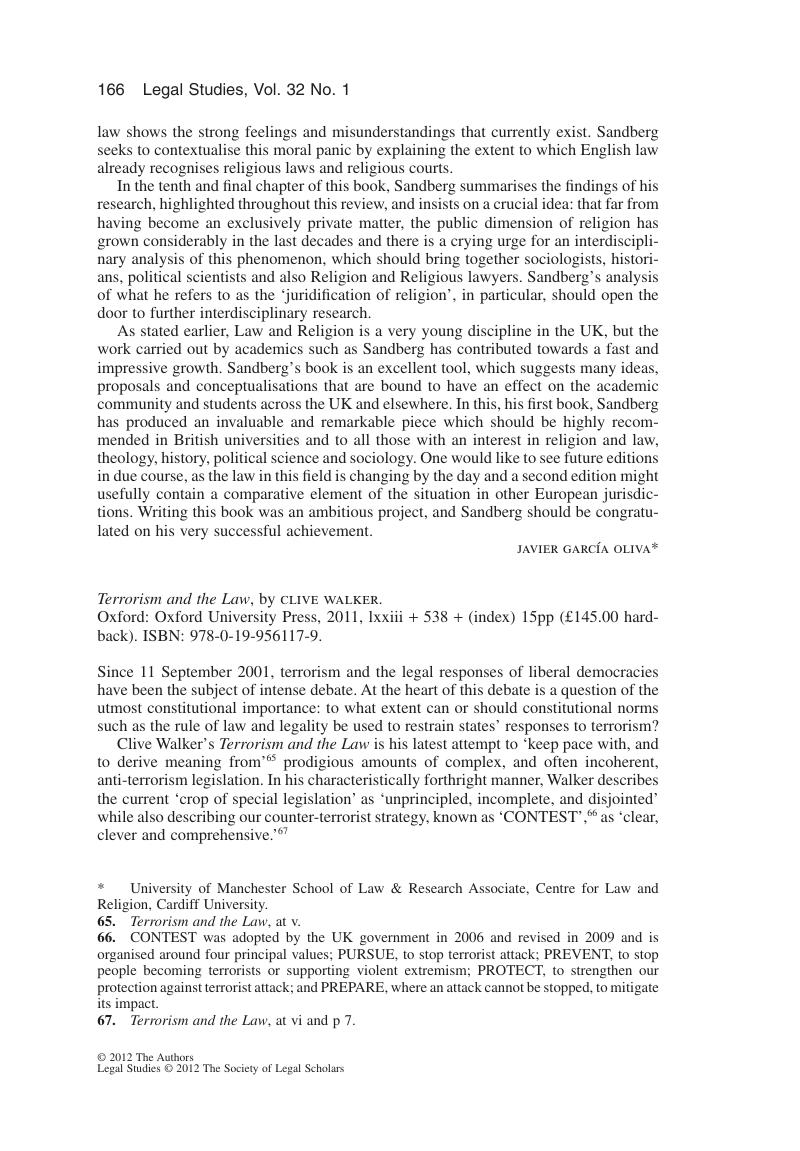No CrossRef data available.
Article contents
Terrorism and the Law, by Clive Walker. Oxford: Oxford University Press, 2011, lxxiii + 538 + (index) 15pp (£145.00 hardback). ISBN: 978-0-19-956117-9.
Published online by Cambridge University Press: 02 January 2018
Abstract

- Type
- Book Review
- Information
- Copyright
- Copyright © Society of Legal Scholars 2012
References
65. Terrorism and the Law, at v.
66. CONTEST was adopted by the UK government in 2006 and revised in 2009 and is organised around four principal values; PURSUE, to stop terrorist attack; PREVENT, to stop people becoming terrorists or supporting violent extremism; PROTECT, to strengthen our protection against terrorist attack; and PREPARE, where an attack cannot be stopped, to mitigate its impact.
67. Terrorism and the Law, at vi and p 7.
68. This contrasts with six pieces of UK-wide anti-terrorism legislation between 1939 and 1996 when ‘the Troubles’ in Northern Ireland were at their height.
69. Terrorism and the Law, at xii.
70. Ibid, p 4.
71. Ibid, p 4.
72. S 20 (1) Prevention of Terrorism (Temporary Provisions) Act 1989.
73. Terrorism and the Law, pp 14–15.
74. Steyn, J ‘Guantanamo Bay’ (2003) 53 International and Comparative Law Quarterly 1 Google Scholar.
75. Since then the UK Supreme Court has made it clear that Guantánamo Bay detainees are entitled to the protections of Common Art 3 of the Geneva Conventions (Hamdan v Rumsfeld (2006) 548 US 557) and at least some constitutional rights (Boumediene v Bush (2008) 553 US 723).
76. Terrorism and the Law, p 16.
77. In October 2008 the Anti-terrorism Crime and Security Act 2001 was used to freeze the British assets of the Icelandic bank Landsbanki following the collapse of the Icelandic financial system; could this truly be said to be an exception to the norm, a state of affairs so dangerous as to justify the use of anti-terrorism legislation?
78. Terrorism and the Law, p 23.
79. Case of Proclamations (1611) 2 Co Rep 74.
80. Terrorism and the Law, p 30.
81. Council for Civil Service Unions v Minister for the Civil Service[1985] AC 374. Cf There is a view that this might be changing; that courts might be becoming more assertive. See for example de Londras, F Detention in the ‘War on Terror’: Can Human Rights Fight Back? (Cambridge: Cambridge University Press, 2011)Google Scholar.
82. Terrorism and the Law, p 47.
83. Home Office ‘Countering International Terrorism: The United Kingdom's Strategy’ (Cm 6888, London, 2006) para 65.
84. Terrorism and the Law, p 56.
85. Ibid, p 108.
86. Ibid, p 115.
87. Home Office Circular 7/2002, p 5.
88. R v Girma[2009] EWCA Crim 912 and R v Abdul Sherif[2008] EWCA Crim 2563.
89. Available at http://www.lawsociety.org.uk/documents/downloads/dynamic/practicenote_terrorismact2000.pdf, p 8.
90. Terrorism and the Law, p 126.
91. Ibid, p 139.
92. The meaning of ‘reasonably suspects’ was considered by the ECtHR in O'Hara v United Kingdom App no 37555/97, 2001-X in which it was held that ‘facts which raise a suspicion need not be of the same level as those necessary to justify a conviction, or even the bringing of a charge.’ The ruling of the court in O'Hara must surely stretch the definitional bounds of the words ‘reasonable’ and ‘suspicion’ almost to breaking point.
93. PACE 1984, s 28 requires that the detained person be informed of the reason for their arrest as soon as practicable, whereas s 41 Terrorism Act 2000 simply requires that the detainee is informed that they are being arrested on suspicion of ‘terrorism’.
94. Terrorism and the Law, p 153.
95. Sir J May Report of the Inquiry into the Circumstances Surrounding the Convictions Arising out of the Bomb Attacks in Guildford and Woolwich, Final Report (1993–1994 HC 449) para 21.8: ‘If all the safeguards of PACE are necessary to avoid miscarriages of justice then it must be recognised that in terrorist cases greater risks of injustice are accepted than in the ordinary course of criminal cases.’
96. Hillyard, P Suspect Community (London: Pluto Press, 1993) p 7 Google Scholar.
97. Terrorism and the Law, p 153.
98. Carlile, Lord Report on the Operation in 2008 of the Terrorism Act 2000 (London: Home Office, 2009) p 66 Google Scholar.
99. Terrorism and the Law, p 154.
100. T McNulty Hansard HC Deb, vol 472, col 561, 21 February 2008.
101. Terrorism and the Law, p 203.
102. For examples of ‘special’ offences see Terrorism Act 2000, s 54 (engagement in weapons training); Terrorism Act 2000, s 56 (directing a terrorist organisation); Terrorism Act 2000, s 57 (possession of items for terrorist purposes).
103. Terrorism and the Law, p 275.
104. Ibid, p 252.
105. Ibid, p 252.
106. Ibid, p 299.
107. Ibid, p 255.
108. Ibid, p v.


